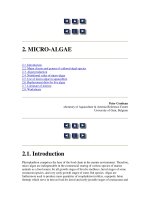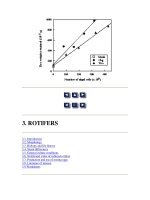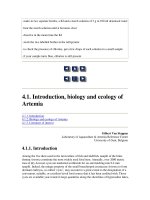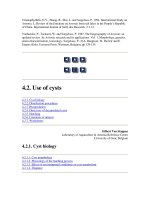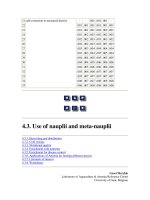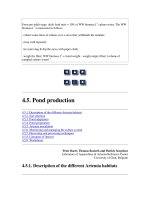The preparation and use of compost - Part 1 ppt
Bạn đang xem bản rút gọn của tài liệu. Xem và tải ngay bản đầy đủ của tài liệu tại đây (172.57 KB, 10 trang )
Agrodok 8
The preparation and use of
compost
Madeleine Inckel
Peter de Smet
Tim Tersmette
Tom Veldkamp
© Agromisa Foundation, Wageningen, 2005.
A
ll rights reserved. No part of this book may be reproduced in any form, by print, photocopy,
microfilm or any other means, without written permission from the publisher.
First edition: 1980
Fifth revised edition: 1999
Seventh edition: 2005
A
uthors: Madeleine Inckel, Peter de Smet, Tim Tersmette, Tom Veldkamp
Translation: Mrs. E.W.M. Verheij
Printed by: Digigrafi, Wageningen, The Netherlands
Third revision by: Mira Louis and Marg Leijdens
ISBN: 90-8573-006-6
NUGI: 835
Foreword 3
Foreword
Foreword to the third revised edition
This booklet has been compiled to give information about how com-
post can be applied in the tropics and subtropics. It gives a simple de-
scription of the processes taking place in the soil and during compost-
ing. Practical suggestions are given for constructing a compost heap. A
few selected compost methods and applications are given and a litera-
ture list has been added for supplementary information.
The reader is advised to first read through the whole booklet to get a
general impression before looking for specific information. We wel-
come, with interest, any remarks, additions or queries about this book-
let or related matters.
The Authors
Wageningen, May 1990.
Foreword to the fourth revised edition
We have made some minor alterations in this third revised edition.
Hopefully this Agrodok will continue to be a help to produce your
own compost.
The publisher
Wageningen, October 1994.
Foreword to the fifth revised edition
We thank Mira Louis for preparing materials for this 5th revision.
KIOF, The Kenyan Institute for Organic Farming in Nairobi, and the
Henry Doubleday Research Association (HDRA) in Coventry, UK,
both gave us valuable information to improve this Agrodok. We are
very grateful to them. Their addresses are given in the back of this
book. We hope that many people will make use of the information
given.
Marg Leijdens, Coordinator Agrodok Publications
Wageningen, 1999.
The preparation and use of compost 4
Contents
1 Reasons for composting 6
2 Fertilizing: the role of organic matter and compost 8
2.1 Organic matter and soil processes 8
2.2 Compost 9
3 The composting process 11
3.1 Heating phase 12
3.2 Cooling down phase 13
3.3 Maturation phase 13
4 The practice of composting 14
4.1 Organic material 14
4.2 Micro-organisms 16
4.3 Air 16
4.4 Moisture 17
4.5 Site of the compost heap 17
4.6 Size and setting up of the heap 19
5 Methods to make compost 22
5.1 Indore method 22
5.2 Bangalore method 24
5.3 Heating process or block method 25
5.4 Pit composting 27
5.5 Trench composting 28
5.6 Basket composting 29
5.7 Boma composting 30
6 Composting specific materials 33
6.1 Composting water plants 33
6.2 Composting seaweed 34
6.3 Composting coffee pulp 35
6.4 Composting domestic waste 36
Contents 5
6.5 Composting human waste or sewage 39
7 Putting compost to use 40
7.1 Fertilizing 40
7.2 Nursery soil, potting soil, planting trees 42
7.3 Erosion prevention and erosion control 43
7.4 Compost for fish feed 43
8 Liquid manure and plant teas 47
8.1 How to make liquid manure and plant teas 47
9 Bokashi 50
9.1 The organic materials 51
9.2 Preparation of bokashi 53
9.3 Applying bokashi 56
10 Your own organic fertilizer 57
10.1 Advantages and disadvantages 57
10.2 Whether or not to start preparing organic fertilizers 58
10.3 Practical questions as a guideline for starting 59
Appendix 1: Composition of organic materials 60
Further reading 62
Useful addresses 64
The preparation and use of compost 6
1 Reasons for composting
Compost is an organic fertilizer that can be made on the farm at very
low cost. The most important input is the farmer’s labour. Compost is
decomposed organic matter, such as crop residues and/or animal ma-
nure. Most of these ingredients can be easily found around the farm.
Agromisa’s Question and Answer Service frequently receives ques-
tions from farmers who face a problem with a decreasing fertility of
their soils. Due to soil fertility problems, crop returns often decrease
and the crops are more susceptible to pests and diseases because they
are in bad condition.
In order to increase soil fertility in the short run, nutrients have to be
added to the soil. This is often done by applying chemical fertilizers.
Chemical fertilizers, however, are expensive to purchase and for most
small-scale farmers this is a problem. Preparation and use of compost
can be a solution to that problem.
To really improve soil fertility in the long term, it is necessary to im-
prove the soil structure and to increase the organic matter content of
the soil. Compost is a good fertilizer because it contains nutrients as
well as organic matter. The role of organic matter is explained in more
detail in Chapter 2.
Using compost as the only means to maintain soil fertility is possible,
but in that case you need a very large quantity of compost. We advise
you to apply several practices at the same time in order to maintain the
soil fertility in the long term.
Some of these methods to improve soil fertility are:
? Crop husbandry methods, such as: mulching, green manure, agro-
forestry and improved fallow.
? Applying organic manures such as: compost, liquid manure and
animal manure.
Reasons for composting 7
If animal manure is applied it should have matured for some time,
other-wise it might damage the plants. Composting animal manure
makes it a better fertilizer.
These methods to improve soil fertlility and others are described ex-
tensively in Agrodok no. 2: ‘Soil fertility management’ and Agrodok
no. 16: ‘Agroforestry’.
Contents of this Agrodok
This Agrodok concentrates on the preparation and use of compost.
Chapter 8 gives a recipe of making liquid manure and plant teas.
These are organic fertilizers that are easily made to supply plants
quickly with nutrients. Bokashi is another type of organic fertilizer,
prepared by fermenting organic matter. In Chapter 9 it is explained in
detail.
This Agrodok has been written for people who work with small scale
farmers in developing countries and for anybody with an interest in
composting and organic fertilizers.
Figure 1: Turning compost (Source: KIOF)
The preparation and use of compost 8
2 Fertilizing: the role of organic
matter and compost
The presence of organic matter in the soil is fundamental in maintain-
ing the soil fertility and decreasing nutrient losses. Compost is an or-
ganic fertilizer; it adds organic matter and nutrients to the soil.
In order to quickly supply a crop with the required nutrients, a chemi-
cal fertilizer may be needed. In contrast to organic fertilizers, chemical
fertilizers help the plants immediately; organic manures first have to
be broken down into nutrients (by soil-organisms) before they can be
utilized by the plants.
However, chemical fertilizers are used up by the end of the season,
whereas organic matter continues to enhance soil fertility, soil struc-
ture and water storage capacity.
Moreover, the presence of organic material ensures that the chemical
fertilizer is more efficiently utilized by the crop. Organic matter re-
tains plant nutrients and thus prevents the fertilizer from being washed
away. It is in fact a waste of money to apply chemical fertilizer on a
soil that is poor in organic matter, if it is not done in combination with
measures to increase the level of organic matter in the soil.
2.1 Organic matter and soil processes
Organic matter in the soil consists of fresh organic matter and humus.
Fresh organic matter can be (dead) plant material, animal droppings,
dead animals etc. The fresh organic matter is transformed into fine
organic matter and humus by soil organisms.
Humus gives the soil a dark color and retains nutrients and water. It
cannot easily be decomposed further. The fine organic matter, and
humus in particular, have the following properties:
Fertilizing: the role of organic matter and compost 9
? it improves the soil structure.
? it improves the resistance of the soil against the erosive action of
rain and wind.
? it retains water and releases it slowly, so that water is available to
the plants (water storage capacity) over a longer period.
? it retains nutrients and releases them to the plants slowly over a
longer period.
? it contains the main nutrients: nitrogen (N), phosphorus (P) and po-
tassium (K), which become available to the plants after decomposi-
tion.
Figure 2: A few soil organisms, some can hardly be seen by the
naked eye
The micro-organisms are mainly responsible for further breaking
down part of the humus into carbon dioxide, water and nutrients for
the plants. This process is called mineralization: nutrients are released
and can be taken up directly by plant roots.
The rate of humus production and mineralization in the soil depends
on a number of factors. In a hot climate the micro-organisms are more
active and the organic materials will break down more rapidly than in
a cold climate. Also the acidity of the soil, the composition of the or-
ganic matter, the humidity and the availability of oxygen strongly in-
fluence the rate of decomposition.
2.2 Compost
The natural decomposition process in the soil can be regulated and
speeded up by man. Organic material is collected, and preferably
The preparation and use of compost 10
stacked in a heap. In the heap the decomposition process is more in-
tensive and the conditions more favourable, because the heap is made
up almost entirely of organic matter. The end product is strongly de-
cayed organic matter with humus and nutrients. This is known as
compost. Compost is used as an organic fertilizer that can be added to
the soil.
Fertilizing with compost means, apart from fertilizing the plants, also
making use of the good properties of organic material as mentioned in
the section above.
Adding compost to sandy soils increases the water retention capacity.
This means that water remains longer in the soil and thus remains
available to plants for a longer time in periods of drought.
All non-toxic, organic materials can be used for making compost. Su-
perfluous and/or waste material are often applied and in this way can
be made use of again. Finally, make sure that the materials used for
composting could not be better used for other purposes, such as cattle
feed.

